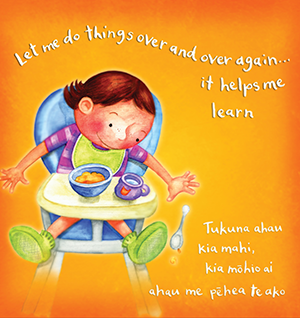
Time on the floor
Giving baby time on the floor is a great way for them to learn about what their body can do and to give them an opportunity to strengthen muscles and practise moving.
Giving pēpi time on the floor is a way for them to learn about what their body can do at their own pace. It also gives them a chance to practise moving.
The firm surface of the floor gives them something to push against, so they can practise pushing up, rolling over, and eventually crawling and standing.
Conversation ideas
Floor safety
Before trying floor time, check the area for choking dangers or sharp objects. Whānau can use floor time with baby to kōrero, waiata, play, and to check it's safe and comfortable. Make sure there is lots of space for baby to move around and spend time in different positions.
Encourage baby
If pēpi and whānau haven’t had a lot of floor time together already, pēpi may not like it, or they may get frustrated if they feel stuck, particularly if they are beginning to roll or reach. A little frustration is okay – let them see if they can work it out first before offering help. Pēpi should be encouraged but should not become distressed. If this happens, whānau should pick them up for comfort and then try again at another time.
Things to try:
- Place baby by the window so they can watch the clouds or the trees.
- Play a favourite game together like peek-a-boo.
- Place toys in front or to the side of them to look at and reach for.
- Chest-to-chest cuddles for newborns and pēpi who don't like being on their tummies.
- Stand open books up in front or to the side of them, with brightly coloured pictures to look at and reach for.
- A mirror can be fun for them to check themselves out in. It does need to be in a position where they can see themselves, without it being a safety hazard.
- Play tickling games and enjoy singing and rhymes with baby.
- Use light scarves or bits of soft material to add to the fun. Gently float them over baby’s skin.
A little regular practice supports baby to enjoy this time so they can learn to roll and move.
Helpful resources for whānau
-

Safekids Aotearoa
Safekids Aotearoa provides practical advice based on international research, local knowledge and mātauranga, to help keep children safe from serious injuries like falls, drowning and incidents on the road.












